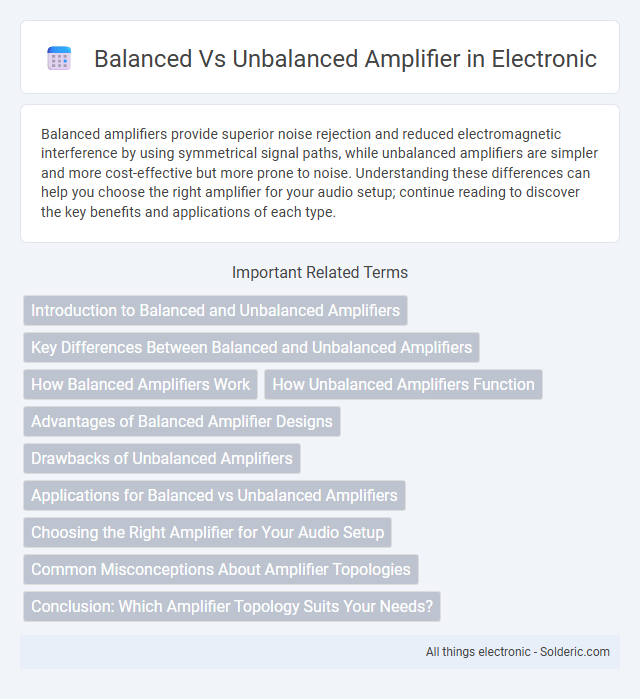Balanced amplifiers provide superior noise rejection and reduced electromagnetic interference by using symmetrical signal paths, while unbalanced amplifiers are simpler and more cost-effective but more prone to noise. Understanding these differences can help you choose the right amplifier for your audio setup; continue reading to discover the key benefits and applications of each type.
Comparison Table
| Feature | Balanced Amplifier | Unbalanced Amplifier |
|---|---|---|
| Signal Type | Uses differential signals on two conductors | Uses single-ended signal on one conductor |
| Noise Rejection | High noise immunity via common-mode noise cancellation | Lower noise rejection, more susceptible to interference |
| Connection Type | XLR or TRS balanced connectors | TS or RCA unbalanced connectors |
| Cable Length | Supports long cable runs (100+ feet) with minimal signal loss | Best for short cable lengths (under 20 feet) |
| Cost | Generally higher due to complexity | Lower cost and simpler design |
| Typical Usage | Professional audio, studio equipment, live sound systems | Consumer audio, simple applications, short runs |
Introduction to Balanced and Unbalanced Amplifiers
Balanced amplifiers use two complementary signal paths that carry equal and opposite signals, minimizing noise and interference for superior audio clarity. Unbalanced amplifiers rely on a single signal path referenced to ground, making them more susceptible to noise, especially over long cable runs. The choice between balanced and unbalanced amplifiers significantly impacts signal integrity in professional audio and high-fidelity sound systems.
Key Differences Between Balanced and Unbalanced Amplifiers
Balanced amplifiers use two symmetrical signal paths to reduce noise and interference, resulting in cleaner audio output compared to unbalanced amplifiers that rely on a single signal path and are more prone to noise. Balanced designs typically offer improved signal integrity and better rejection of electromagnetic interference, making them ideal for professional audio and long cable runs. Your choice between the two depends on the environment and application, with balanced amplifiers preferred for high-fidelity setups and unbalanced amplifiers suited for simpler, cost-effective systems.
How Balanced Amplifiers Work
Balanced amplifiers operate by utilizing two identical amplification paths that handle opposite phases of the input signal, effectively reducing noise and distortion. Each amplifier processes a differential signal, and the outputs combine to reinforce the desired signal while canceling common-mode noise. This design enhances signal integrity, making balanced amplifiers ideal for professional audio and high-fidelity applications.
How Unbalanced Amplifiers Function
Unbalanced amplifiers operate by using a single conductor to carry the audio signal alongside a ground reference, which makes them more susceptible to noise and interference. These amplifiers are commonly found in consumer audio equipment due to their simpler design and lower cost compared to balanced amplifiers. Your audio setup using unbalanced amplifiers may experience more signal degradation over long cable runs or in environments with high electromagnetic interference.
Advantages of Balanced Amplifier Designs
Balanced amplifier designs offer superior noise rejection and improved signal integrity by utilizing two symmetrical signal paths that cancel out common-mode noise and interference. They provide better power efficiency and reduced distortion, resulting in clearer audio performance and higher fidelity. These amplifiers are especially beneficial in professional audio and communication systems where minimizing signal degradation is critical.
Drawbacks of Unbalanced Amplifiers
Unbalanced amplifiers often suffer from increased susceptibility to noise and electromagnetic interference due to their single-ended signal paths, which can degrade audio quality. Their inability to reject common-mode signals makes them less effective in maintaining signal integrity over longer cable runs or in electrically noisy environments. Your setup may experience hum, ground loops, and signal degradation when relying solely on unbalanced amplifiers compared to balanced designs.
Applications for Balanced vs Unbalanced Amplifiers
Balanced amplifiers are commonly used in professional audio equipment, telecommunications, and radio frequency (RF) applications where noise rejection and signal integrity over long cable runs are critical. Unbalanced amplifiers are typically found in consumer electronics and short-distance connections where simplicity and cost-effectiveness are prioritized. Your choice between balanced and unbalanced amplifiers should consider the specific application environment, signal length, and noise susceptibility requirements.
Choosing the Right Amplifier for Your Audio Setup
Choosing the right amplifier for your audio setup depends on the balance between noise reduction and signal clarity. Balanced amplifiers use differential signaling to minimize interference and deliver cleaner audio, ideal for long cable runs or professional environments. Unbalanced amplifiers, while simpler and more cost-effective, may introduce more noise, making them suitable for shorter connections and casual listening.
Common Misconceptions About Amplifier Topologies
Balanced amplifiers often get misconceived as always superior to unbalanced designs due to their noise rejection and signal integrity, but performance depends heavily on implementation quality. Unbalanced amplifiers, while simpler and more cost-effective, can achieve comparable audio fidelity when properly designed and paired with appropriate components. Misunderstandings arise from ignoring factors like circuit layout, power supply quality, and application context rather than just the topology itself.
Conclusion: Which Amplifier Topology Suits Your Needs?
Balanced amplifiers offer superior noise rejection and improved signal integrity, making them ideal for professional audio applications requiring high fidelity. Unbalanced amplifiers provide simplicity and cost-efficiency, suitable for consumer electronics and low-interference environments. Choosing the right amplifier topology depends on the specific needs for noise performance, system complexity, and budget constraints.
Balanced vs Unbalanced amplifier Infographic

 solderic.com
solderic.com